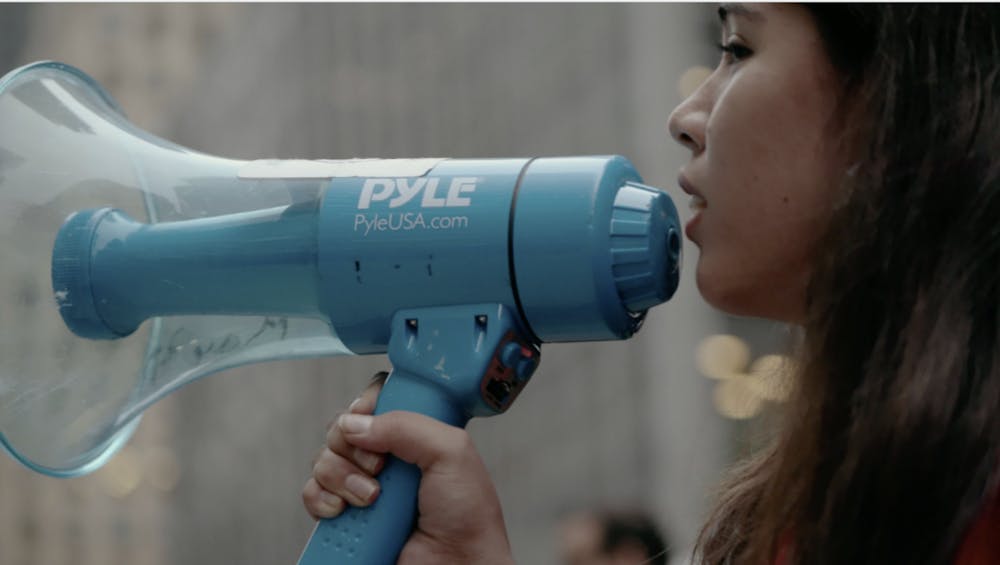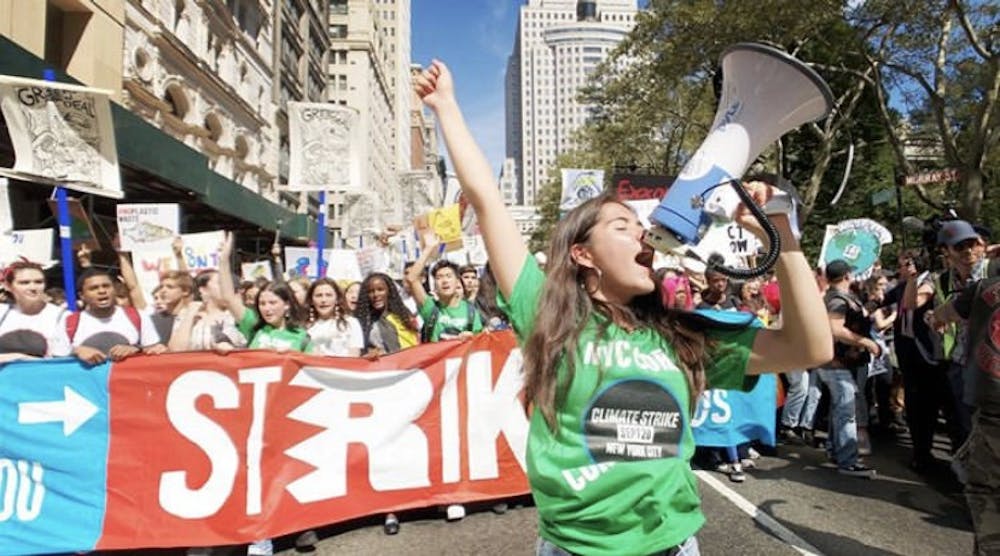September 20, 2019. Xiye Bastida (C '24) expected 18,000 people, maybe, at most. Instead, she found hundreds of thousands walking alongside her down Wall Street, rallying for climate change and chanting something along the lines of “Wall Street, Wall Street, we see your lies!”
It’s a day that climate activist Xiye will never forget.
“It gives me chills to just remember that,” she says, her face lighting up as she recalls the strike. “It was the most amazing day ever because everybody came together—everybody believed that everybody could come together.”
Two months of planning—of late nights and early mornings spent at her friend’s house while her family was in Mexico, of subsisting off of coffee and pizza, of emails and flyers and more emails—went into organizing the climate strike. And while this event is the one she’s most proud of, Xiye’s climate justice work extends far beyond September of 2019. From organizing protests for the Fridays for Future youth climate strike movement, to giving a TED Talk, to co–founding her own organization Re-Earth Initiative, Xiye has made her mark.
She can’t pin down the exact moment in which she realized that something needed to be done about the earth, but she had begun recognizing the climate crisis at an early age. “It was more of a gradual process,” she says, “of realizing where humanity is at right now.”
Born and raised in a small town in Mexico, Xiye’s perspective of the climate crisis was influenced by her dad, a member of an indigenous community in Mexico. “I was raised with indigenous philosophy, which is one of reciprocity and one of taking care of the earth and just being aware of our relationship with the world around us.”
Growing up in a town that was home to several factories, Xiye saw firsthand the impact of mistreating the environment. The factories polluted her hometown’s river and drained their aquifers, leaving them without clean water.

“Our water wasn’t even our own,” she recalls. “It had to be shipped from Mexico City. [Looking back now], I realize that we were experiencing environmental racism, a lack of resources—a lack of our own access to clean air and clean water—because we were a small minority community. I wasn’t really aware of that [at first], but I was aware that our relationship with Mother Earth was being ruptured.”
Then, five years ago, one day before she and her family moved to New York City, her town flooded. Toxic waste from the polluted river overflowed, damaging crops and businesses and creating an environmental and health hazard for her community. And once she arrived in New York, she saw the ongoing effect of Hurricane Sandy’s devastation, even though it had been years since the storm made landfall.
“That was a moment in which I realized several different things,” Xiye says. “One, the climate crisis is happening right now, not in a hundred years. Second thing is it’s affecting more vulnerable and low–income communities, and it’s happening all over the world. You really cannot think ‘Oh, it’s happening here and not here.’ It’s affecting communities all over the place, just in different ways.”
While Xiye is notably a climate justice activist, she also advocates for an awareness of intersectionality concerning the climate and other issues such as racism and indigenous rights, like in her hometown, or gender equality, or food waste.
“I cannot talk about climate without talking about our food choices and the food industry and how much food goes to waste in the U.S.,” she adds. “I cannot be a climate activist without talking about food and agriculture. I cannot neglect the water crisis and I cannot neglect the plastic crisis and the textile industry and fashion. There’s just so many things that, when you think about it, they’re all connected.”
And being 18 and a part of a movement that’s largely composed of young people, Xiye recognizes the power of youth voices. At 15, Xiye filled in for her dad at the United Nations World Urban Forum in Malaysia and spoke, for the first time, to an older generation about indigenous voices and the generational injustice of the climate crisis. “That’s when I realized the power that [our generation] actually has to walk into rooms and say, you know, it’s unfair what you’re doing, not only for my community, but also my generation,” she says.
While today many of us associate the climate movement with young people, it’s only recently been centered around youth voices. Xiye traces this shift back to 2018, when the Intergovernmental Panel on Climate Change issued the Special Report on Global Warming of 1.5°C—basically, we have 12 years, starting from 2018, to reduce carbon emissions and limit global warming to 1.5°C, or a moderate level of warming.
“That [now] 10–year frame, that 10–year deadline, is what drew all these youth to actually say, ‘Oh, this is not only an attack on communities and different countries and an exploitation of different countries, but it’s also an attack on our generation,’” Xiye notes.

Even though the pandemic prevents Xiye from organizing in–person strikes, her being forced to adapt has led to new ways of getting people involved. “We had to completely shift our way of organizing,” Xiye says. “A lot of great things were born out of the crisis of the pandemic because we realized that we had been very narrow with our activism. We had only given people the opportunity to strike—nothing else.”
After having to scrap the plans she and others had made for an Earth Day climate strike, Xiye helped organize a campaign where 300,000 people virtually pledged to take individual and systemic action. That campaign turned into the Re–Earth Initiative, an organization she co–founded that focuses on making the climate movement more accessible. Now at Penn, Xiye’s is participating in Sustainability Challenge, and in the next few years, she hopes to become more deeply involved with the Philly community by joining more environmental groups and putting pressure on the Penn administration to consider the environment in their investments.
Balancing being an activist, teenager, and Penn student can be difficult, but what helps Xiye is a matter of perspective—recognizing that not everything has to rest on her shoulders. For a while, she felt like she constantly had to be doing more—more panels, more organizing, more Instagram Lives—all while juggling high school and applying to college. But that began hurting her health.
“I stepped back and realized that it’s not about having a few perfect activists to do everything, but it’s about inviting the billions of people around the world to do their best,” Xiye reflects. “So now, I think that’s a more powerful message: don’t just follow your favorite climate activists on social media, but actually become the best version of yourself when it comes to helping people around you on the earth.”
Xiye hopes people realize that just as the climate crisis is intersectional, so are the solutions. Not everyone's contribution has to look the same way. “I’m not asking you to change your entire way of life just to be part of the climate movement,” she says. “I’m asking you to grab your passion and say, ‘How can I exercise my passion through a climate lens?’ And that can be photography, writing, dancing, music creation, graphic design. Whatever your passion is, you can use it to be part of the movement. That’s what I want people to realize—that everything connects to climate, but also everything you do can be part of the solution.”

